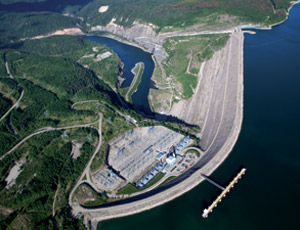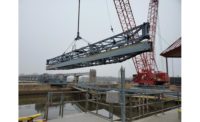Large dam upgrades in North America are squeezing every megawatt out of the grid as efficiently as possible by converting century-old powerhouses and replacing decades-old turbines. Construction is under way at several sites, from Pennsylvania to British Columbia. Earlier this month, PPL Montana began upgrading its Rainbow Dam, a 36-megawatt dam on the Missouri River, six miles northeast of Great Falls, Mont., where 200 workers are under the direction of Chicago’s Walsh Construction.

PPL Montana says the $230-million, 30-month project is the state’s single-largest energy investment in roughly 30 years. David Hoffman, PPL’s external affairs director, says the upgrade will increase dam capacity by more than 70% without changing the river flow.
PPL will turn 36 MW into 62 MW with a new powerhouse 200 ft downstream from the existing 100-year-old structure, which has foundation issues. Work on the new eight-unit hydroelectric plant is scheduled for completion by spring 2012. Hoffman says crews already have completed excavation, laid concrete foundations and performed some steel fabrication and electrical work.
Crews will build a cofferdam to isolate the construction location and dewater the area in order to rebuild the intake mechanism at the 1,055-ft-long and 29-ft-high structure. An open, concrete-bottomed channel about a half mile in length will send 8,500 cu ft per second of water to the new powerhouse.
The new turbines will rotate slower and have wider flow passages with fewer rotating surfaces, making it easier for fish to pass through unharmed.
Help From DOE and ARRA
Walsh also is updating another 100-year-old PPL-owned structure, the 10-unit Holtwood plant on the Susquehanna River about 15 miles south of Lancaster, Pa. There, PPL took advantage of the U.S. Dept. of Energy’s portion of the American Recovery and Reinvestment Act on the $434-million project to increase capacity by 125 MW, also while improving fish passage on what is currently a 108-MW facility.
New powerhouse construction began in January, and the entire project—including two new turbines from York, Pa.-based Voith Hydro—is expected to be complete in spring 2013. The existing powerhouse will remain in operation.
Within the Bonneville Power Administration’s hydro system, five dam projects totaling $250 million will help “sustain the backbone of the region’s renewable power supply, keep rates low by avoiding the need to develop other, more expensive resources, and reduce the need for fossil-fuel plants,” says Katie Pruder-Scruggs, a spokeswoman for BPA.
The largest BPA project is a $120-million turbine upgrade at Chief Joseph Dam on the Columbia River in eastern Washington—the second-largest hydropower-producing dam in the U.S. Under contract with the U.S. Army Corps of Engineers, Alstom Hydro will install 10 new turbine runners by 2014. The new runners and related turbine component repairs and replacements will increase the dam’s power generation by more than 40 MW and boost the efficiency of the turbines to 95% or better.
A little farther north, BC Hydro is upgrading five turbine units at its Gordon M. Shrum powerplant at the W.A.C. Bennett Dam. Under way this year, the project, being completed by Voith Hydro Canada, will replace one unit per year until all five are in service in early 2017, bringing total production to 310 MW, up from the current 266-MW capacity.
The 1960s-era units currently represent 12% of BC Hydro’s power production. Darren Solmundson, BC Hydro’s project manager, says each unit takes seven months to finish. BC Hydro cannot afford to take more than one turbine out of service at a time.
Improvements aren’t limited to utilities. Alcoa Power Generating Inc. began upgrades to its 90-year old, 107-MW Cheoah Dam on North Carolina’s Little Tennessee River in August with the aid of $12.9 million from ARRA and $110 million from the private sector. The refurbished five-turbine dam will boost production to 129 MW and reduce the plant’s dependence on fossil fuels by 60%.
Kristen Nelson, spokeswoman for the National Hydropower Association, says that, even beyond what is happening now, looking to add power-generating capabilities to existing non-generating dams looks “particularly promising.”
American Municipal Power Inc. is beginning construction on the largest of its six run-of-river powerplants on the Ohio River near Maysville, Ky. There, six new powerhouses on existing dams eventually will add 350 MW to the grid. The star of the project is the 105-MW, $500-million powerplant being installed at the Meldahl Locks & Dams. Contractor Angelo Iafrate, Warren, Mich., is already working on excavation and a cofferdam at Meldahl before getting ready for a cast-in-place, reinforced-concrete powerhouse set on rock for the three turbine generators.
In a similar project, Brookfield Renewable Power has taken over a license and is in the advanced planning stages of a 75-MW powerplant on the Melvin Price Lock and Dam in Alton, Ill.
| 62MW from 36 | Rainbow Dam, PPL Montana 6 miles north of Great Falls |
| 125MW from 108 | Holtwood Dam, PPL Montana15 miles south of Lancaster, Pa. |
| 129MW from 107 | Cheoah Dam, Alcoa PowerRobbinsville, N.C. |
| 105MW from Zero | Meldahl Locks & Dam, AMP Ohio River near Maysville, Ky. |
| 310MW from 266 | Shrum Dam, BC HydroHudson’s Hope, British Columbia |
| 2,654MW from 2,614 | Chief Joseph Dam, BPABridgeport, Washington |



Post a comment to this article
Report Abusive Comment